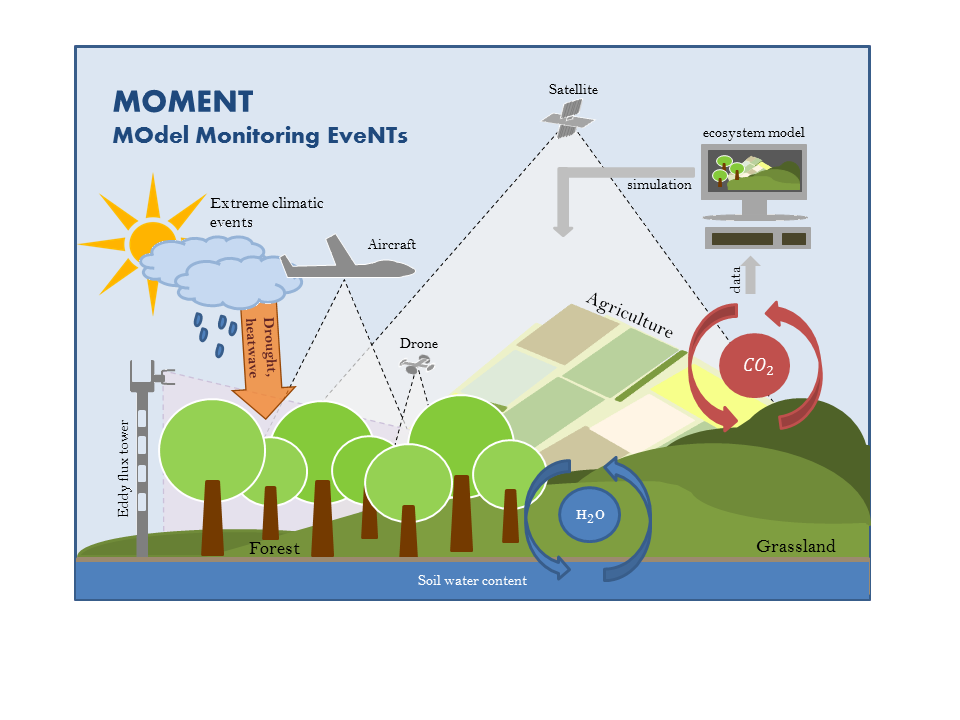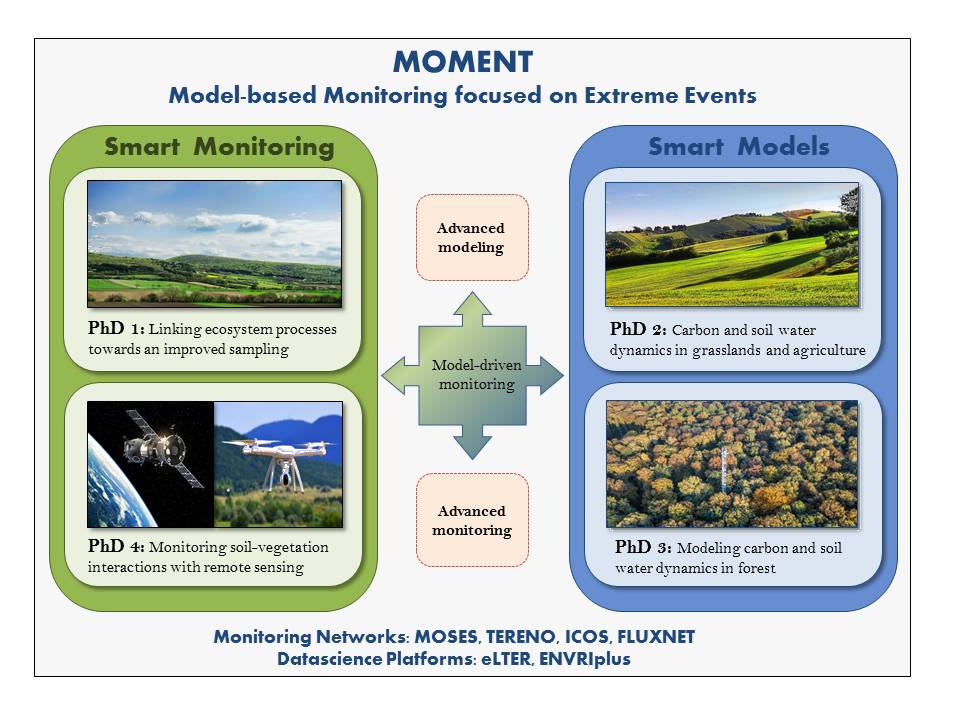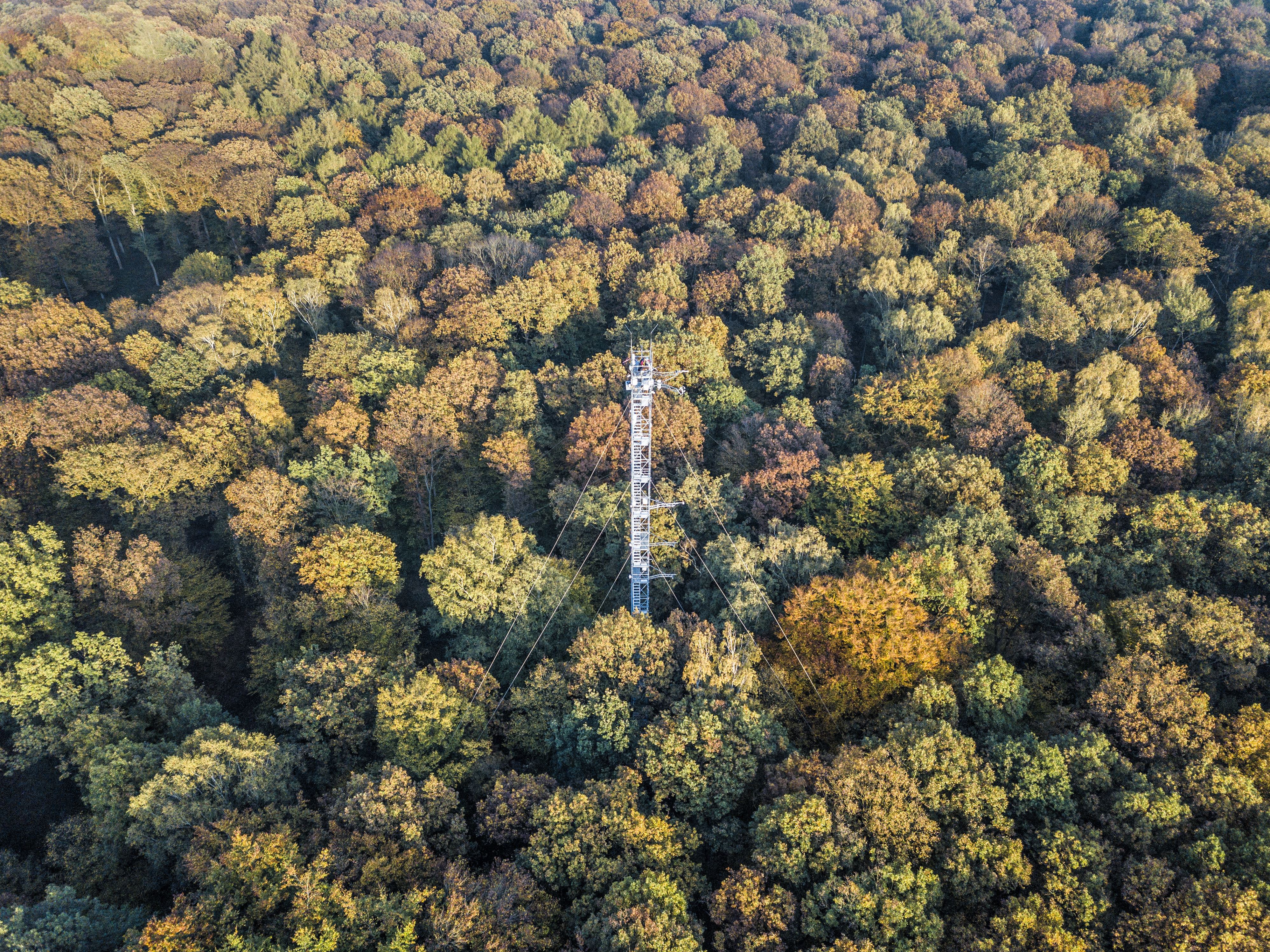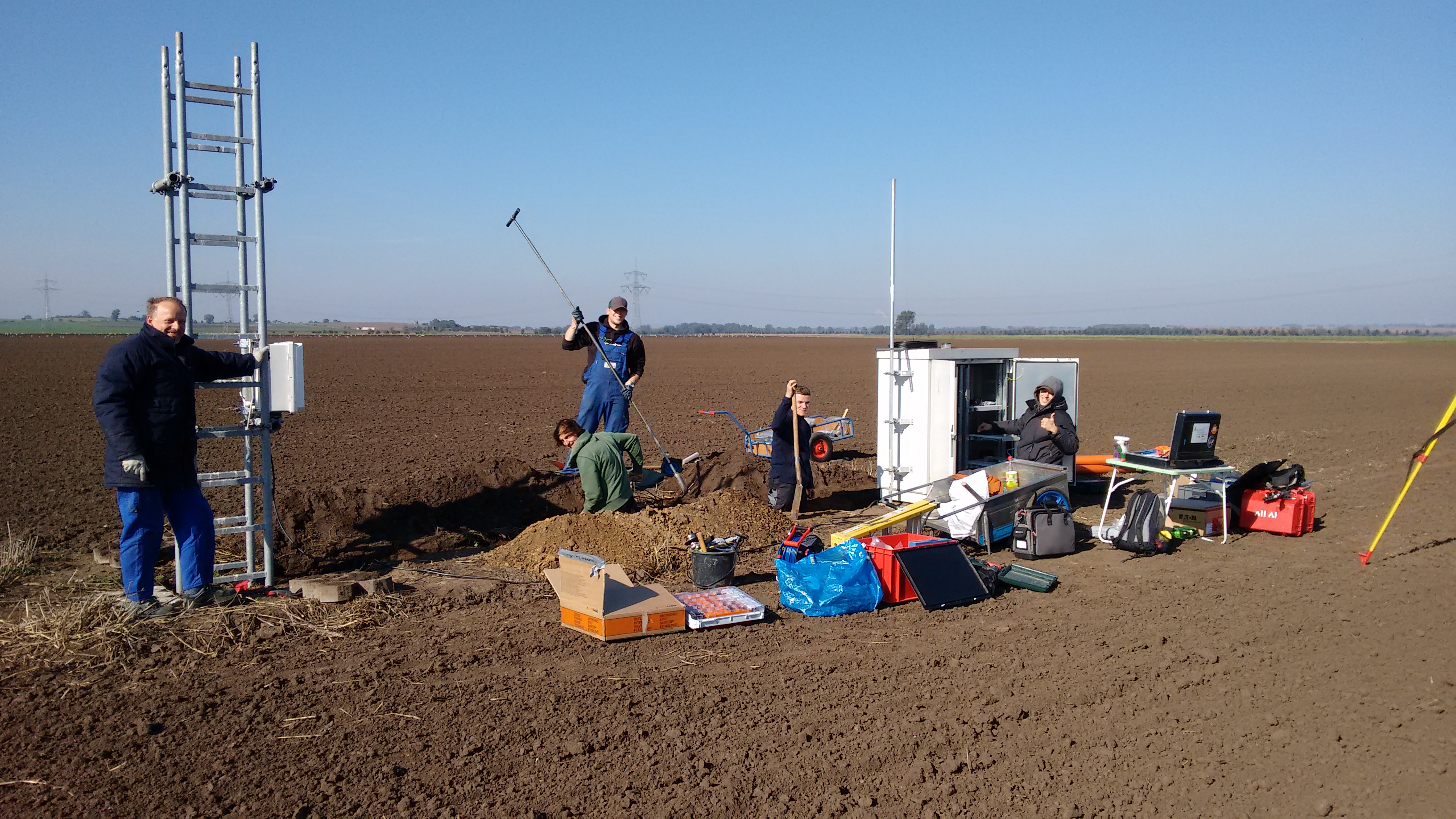MOMENT

Towards improved understanding of the coupled water and carbon cycles of terrestrial ecosystems with special focus on extreme events
The project MOMENT (MOdeling Monitoring EveNTs) investigates the interplay between carbon and water cycles for three biomes: forest, grassland and agriculture with special focus on the impacts of extreme hydrologic and climatic events as well their long-term trends. Four PhD projects will collaborate to analyze the complex feedback processes of these biogeochemical cycles, such as carbon exchange, soil water dynamics and the driving forces.

The aim of this project is to investigate new monitoring and modeling methods to understand the interplay between carbon and water cycles of ecosystems on different time and spatial scales. This will be achieved by combining local field measurements of carbon, water and energy fluxes and their driving forces with remote sensing measurements (e.g., optical data, lidar) and model-based simulations. From these analyses the project aims to develop adaptive sampling strategies and to improve the understanding of ecosystem processes under changing environmental conditions with increasing frequencies of extreme events in order to reduce model uncertainties.
Key Questions
- How do climatic and hydrologic extremes influence ecosystem processes that are relevant for the coupled carbon and water cycles?
- How can we determine changes of the water cycle that effect carbon fluxes in forests/agricultural areas/grasslands and their complex feedback?
- Are there essential impact differences considering the rate of occurrence, the magnitude, timing, spatial extent or structure of extreme events? How can we detect (and quantify) the severity of extreme events on the intertwined water and carbon fluxes and storages?
- What are the responses of different biomes (eg. forest, grassland) to extreme events? And what are the underlying mechanisms that shape the ecosystem’s functioning under changing environmental conditions?
- Which essential variables are required for measuring and analyzing the causes and impacts of extreme events on the coupled water and carbon cycle?
- Which methods and modeling techniques can be used to bridge the different spatial scales from plot to regional scale and beyond?
Research Context and Knowledge gaps
Apart from rising temperatures, climate change is accompanied by an increased frequency of extreme events such as droughts, heat waves or heavy rainfall which are often regional or local phenomena (Reichstein 2013) on timescales of days to several years (Gil et al., 2011). These extreme events may trigger changes in ecosystem structure, species composition or functioning, consequently affecting regional and global biogeochemical cycles, and thus the climate system. However, our understanding of these feedback and interactions between climate and biogeochemical cycles is still not complete. One reason is the huge variability of ecosystems and their internal structure, as well as the duration and intensity of extreme events. The same driving factor may have totally different impacts on different temporal and spatial scales, which are difficult to capture, both in measurements and earth system models, respectively. Especially lagged effects or indirect impacts that could alter the carbon cycling years to decades after the extreme event are difficult to quantify or to link with a specific event (Sippel et al., 2018). Another reason is the different responses of ecosystems, such as forests, grasslands and agriculture areas to extreme events due to different plant mechanisms like growth patterns that influence the carbon dynamics under climate variability (Sippel et al., 2018, Larcher 2013). However, a better understanding of the water and carbon cycle in forests, grasslands and agriculture areas is essential in order to predict ecosystem responses in the frame of climate change effects, especially because the frequency of climatic extremes is increasing (Sippel et al., 2018). Therefore this project will help to get a more complete picture of the consequences of extreme events on the three mentioned ecosystem types at different temporal and spatial scale. This will be achieved by linking different kinds of measured, monitored and modeled data from three test sites for forest, grassland and agriculture biomes.
Collaboration and integration
By analyzing existing data sets acquired in the UFZ TERENO / ICOS observatory for model developments, a close connection to TERENO will be established by the PhD-college. In this first stage, flux data from the UFZ TERENO/ICOS stations will be used, but additional data from other ICOS stations in Germany and Europe is accessible. In addition, MOSES will gain additional value by the above mentioned goal with respect to adapted monitoring strategies. Hence, the proposed research will be embedded in this comprehensive Helmholtz initiative. For synthesis and model integration we will use Data Science approaches (Semantic Web, Web 4.0) and the ENVRIplus platform (Earth System Research Infrastructures) for linking, integration and synthesis of all project data with the interdisciplinary and interoperable cluster of Environmental Research Infrastructures across Europe such as ICOS or eLTER.
Outline of the project

The overall aim of the project is to analyze the complex feedback processes between the carbon and water cycles of forest, grassland and agriculture in the frame of climate change effects. A data-driven, monitoring approach (PhD 1 und PhD 4) is linked with a model-based approach (PhD 2 and PhD 3) to investigate these processes on different temporal and spatial scales. The analysis is based on a large dataset of observations such as carbon, energy and water fluxes obtained since 2013 at TERENO/ICOS stations on forest, grassland and agricultural landscapes. The ain analysis of this data is carried out within PhD project 1. This investigation will improve the knowledge about the underlying processes of the biogeochemical cycles and will help to understand how abiotic variables and physiological plant mechanisms shape the functioning of ecosystems. These findings will be integrated into process-based system models in order to simulate and evaluate the long term behavior of ecosystems under climate change effects. The simulation of scenarios will help to decipher the (potentially decisive) role of the increasing frequency and intensity of extreme events on ecosystem functioning. In this model-based part, PhD 2 will focus on grasslands and agricultural areas, whereas PhD 3 will concentrate on forests. In addition, the integration of remote sensing measurements of the terrestrial biosphere will help to describe the impacts and development of such extreme events on larger scales (PhD 4). The aim of the latter is to develop and evaluate new methods and procedures which can scale outputs from the plot or ecosystem-level up to regional and country scale to face the existing temporal and spatial mismatch between short term events and long term tailing effects on larger scale.
PhD student: Felix Pohl (CHS)
Supervising team: Dr. Corinna Rebmann (CHS) and Dr. Ulrike Werban (MET)
The analyzed data includes flux, meteorological and biological data, as well as soil and biomass parameters combined with footprint analysis and (geo-) statistical methods including machine learning approaches. From this analysis future sampling strategies adapted to extreme events as well as site specific parameter relationships shall be derived and later used for a model based approach (PhD 2 and PhD 3). Findings of this PhD project should also advance the definition of essential variables for the early and targeted recognition of the effects of extreme events. These identified variables could be used in interaction with the results of the other PhD projects to upscale the results from the ecosystem scale to regional scales.
PhD student: Bahar Bahrami (CHS)
Supervising team: Dr. Rohini Kumar (CHS) and Dr. Uwe Franko (BOSYS)
PhD student: Anne Holtmann (née Piechulla)
Supervising team: Dr. Rico Fischer (OESA) and Dr. Corinna Rebmann (CHS)
The third PhD project focuses on the impacts of extreme events on the coupled carbon and water dynamics of forest ecosystems. Therefore observed data (like eddy covariance measurements) from the TERENO test site ‘Hohes Holz’ will be linked with a process-based forest model (here FORMIND). This allows the extension of results from PhD 1 by a model-driven evaluation of the consequences of extreme events and to predict long term behavior of forests under climate change. Additionally, the simulation of different scenarios can help to analyze how the characteristics of extreme events, like different frequency or severity of e.g. droughts, affect the carbon cycling and to understand lag effects on forest dynamics. One result of this PhD will be the determination of essential variables for an early recognition of the effects of extreme events e.g. with Remote Sensing measurements. This linkage between forest modeling and remote sensing measurements would allow an upscaling of these findings to a regional scale in cooperation with PhD 4. In the end, an innovative and transferable workflow to other FLUXNET locations shall be developed that allows to integrate eddy covariance data into the process-based forest model to improve the understanding of the coupled carbon and water dynamics.
PhD student: Floris Hermanns (CLE)
Supervising team: PD Dr. habil Angela Lausch (CLE), Dr. Ulrike Werban (MET)
Remote sensing measurements of the terrestrial biosphere provide an important reference for detecting and describing the development of extreme events on larger scales. The aim of this PhD project is to develop new methods that are suitable to increase the accuracy of these large scale observations (long term regional and global air- and spaceborne RS) by 1) attributing Essential Remote Sensing Variables to locally measured fluxes and drivers and 2) linking this data with local high frequency RS sensor networks and ecosystem models (PhD 2 and PhD 3). This linkage would increase the understanding of the interactions between subsurface, vegetation, and atmosphere and their spectral response under different climate conditions such as extreme events. In the frame of this project, remote sensing measurements shall be evaluated to detect changes that occur after extreme events. Based on these observations, the PhD should detect remote sensing indicators and ecosystem variables for an early recognition of extreme events that could drive the monitoring and modeling of relevant processes. These indicators could also help to quantify the impacts on larger scales.
Study Sites
All study sites of this project are part of the TERENO (TERrestrial ENviromental Observatories) project and the ICOS (Integrated Carbon Observation System) Research Infrastructure. The main research aim of the TERENO/ICOS observatory network is to increase the understanding of the energy and trace gas fluxes between different ecosystems and the atmosphere in order to investigate the influence of land use and climate change (Wollschläger et al., ). The three test sites studied in the MOMENT project are the forest site called “Hohes Holz’”, the pasture site “Am Grossen Bruch” and “Hordorf”, an agricultural site. These three study sites are located close to each other in central Germany within the Bode catchment in the foreland of the Harz mountains in Saxony-Anhalt. Therefore, the three study sites are located in the same climate region, allowing a comparison of the interactions between climate, carbon, water and energy fluxes and land use types. At all sites, carbon, water and energy fluxes between the ecosystem and the atmosphere are measured with the Eddy covariance technique. Additionally, soil moisture, soil temperature and other meteorological and biological data (e.g. temperature, precipitation, LAI, stem increment), as well as soil properties, are recorded.

The area "Hohes Holz" is a deciduous mixed beech forest with a size of approx. 15 km². The most common tree species are oak and beeches as well as some birch trees. The carbon, water and heat fluxes are measured since 2014 on an Eddy covariance tower at 49 m height.
 André Künzelmann (UFZ)
André Künzelmann (UFZ)
The study site "Am Grossen Bruch" is mainly covered by extensively managed grassland used as pasture. Since 2012 carbon and water fluxes were measured with the eddy covariance technique. Additionally since 2013 also the methane fluxes were recorded, to determine the water level dependent fluxes of the former fen area. Due to the fact that this area is extensively managed, grazing cows are observed to separate their contribution to the methane fluxes of the ecosystem.
 André Künzelmann (UFZ)
André Künzelmann (UFZ)
The study site "Hordorf" named after the nearby village Hordorf is located south of Oschersleben. This area is dominated by intensive agriculture. On this site crop is rotating after a seasonal crop rotation management practice. An Eddy covariance tower placed in the centre of this site is equipped with similar instrumentation as for the other sites to measure carbon, water and energy fluxes together with driving variables since end of 2015.
Team
Dr. Corinna Rebmann (CHS)
Dr. Rico Fischer (OESA)
Dr. Rohini Kumar (CHS)
PD Dr. Angela Lausch (CLE)
Dr. Ulrike Werban (MET)
Dr. Uwe Franko (BOSYS)
Anne Piechulla (OESA)
Floris Hermanns (CLE)
Felix Pohl (CHS)
Bahar Bahrami (CHS)
Contact
Dr. Corinna Rebmann (CHS)
Dr. Rico Fischer (OESA)
Dr. Rohini Kumar (CHS)
PD Dr. Angela Lausch (CLE)
Anne Piechulla (OESA)
- FORMIND – the forest model
- Helmholtz Alliance “Remote Sensing and Earth System Dynamics”
- Terrestrial Environmental Observatories -TERENO
- Intergrated Carbon Observation System - ICOS
- FLUXNET - eddy covariance flux measurements
- Moses - observing system of the Helmholtz Association
- Mesoscale Hydrologic Model - mHM
- Bonan, G. B. (2008). Forests and Climate Change: Forcings, Feedbacks, and the Climate Benefits of Forests. Science, 320(5882), 1444–1449. https://doi.org/10.1126/science.1155121
- Fischer, R.,et al., (2016). Lessons learned from applying a forest gap model to understand ecosystem and carbon dynamics of complex tropical forests. Ecological Modelling, 326, 124–133. https://doi.org/10.1016/j.ecolmodel.2015.11.018
- Frank, D.,et al., (2015). Effects of climate extremes on the terrestrial carbon cycle: Concepts, processes and potential future impacts. Global Change Biology, 21(8), 2861–2880. https://doi.org/10.1111/gcb.12916
- Frank, D.,et al., (2015). Effects of climate extremes on the terrestrial carbon cycle: Concepts, processes and potential future impacts. Global Change Biology, 21(8), 2861–2880. https://doi.org/10.1111/gcb.12916
- Reichstein, M., et al., (2013). Climate extremes and the carbon cycle. Nature, 500(7462), 287–295. https://doi.org/10.1038/nature12350
- Samaniego, L., Kumar, R., & Attinger, S. (2010). Multiscale parameter regionalization of a grid ‐ based hydrologic model at the mesoscale. 46, 1–25. https://doi.org/10.1029/2008WR007327
- Sippel, S.,et al., (2018). Drought, Heat, and the Carbon Cycle: a Review. Current Climate Change Reports, 4(3), 266–286. https://doi.org/10.1007/s40641-018-0103-4
- Wollschläger, U., et al., (2017). The Bode hydrological observatory: a platform for integrated, interdisciplinary hydro-ecological research within the TERENO Harz/Central German Lowland Observatory. Environmental Earth Sciences, 76(1), 29. https://doi.org/10.1007/s12665-016-6327-5
